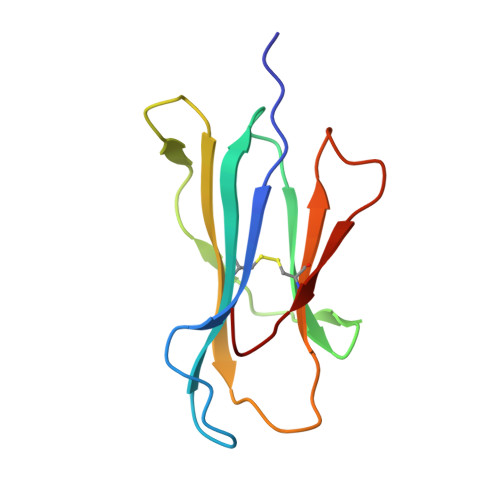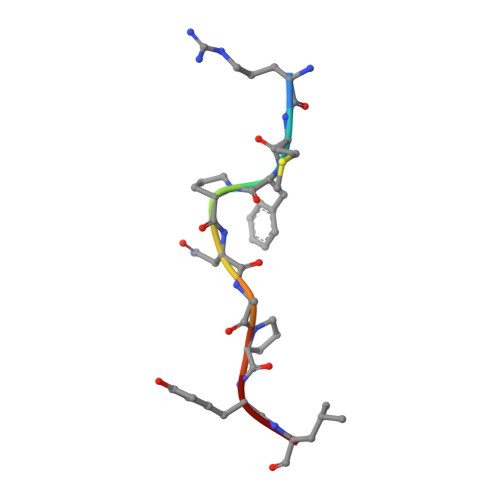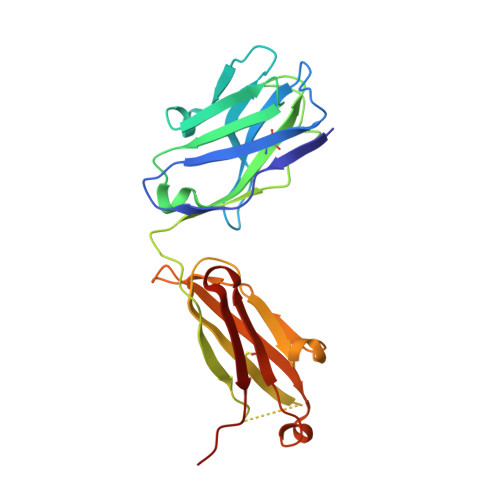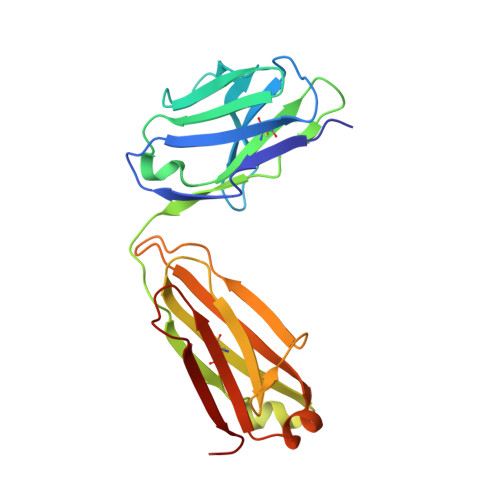Targeting intracellular WT1 in AML with a novel RMF-peptide-MHC-specific T-cell bispecific antibody.
Augsberger, C., Hanel, G., Xu, W., Pulko, V., Hanisch, L.J., Augustin, A., Challier, J., Hunt, K., Vick, B., Rovatti, P.E., Krupka, C., Rothe, M., Schonle, A., Sam, J., Lezan, E., Ducret, A., Ortiz-Franyuti, D., Walz, A.C., Benz, J., Bujotzek, A., Lichtenegger, F.S., Gassner, C., Carpy, A., Lyamichev, V., Patel, J., Konstandin, N., Tunger, A., Schmitz, M., von Bergwelt-Baildon, M., Spiekermann, K., Vago, L., Jeremias, I., Marrer-Berger, E., Umana, P., Klein, C., Subklewe, M.(2021) Blood 138: 2655-2669
- PubMed: 34280257
- DOI: https://doi.org/10.1182/blood.2020010477
- Primary Citation of Related Structures:
7BBG - PubMed Abstract:
Antibody-based immunotherapy is a promising strategy for targeting chemoresistant leukemic cells. However, classical antibody-based approaches are restricted to targeting lineage-specific cell surface antigens. By targeting intracellular antigens, a large number of other leukemia-associated targets would become accessible. In this study, we evaluated a novel T-cell bispecific (TCB) antibody, generated by using CrossMAb and knob-into-holes technology, containing a bivalent T-cell receptor-like binding domain that recognizes the RMFPNAPYL peptide derived from the intracellular tumor antigen Wilms tumor protein (WT1) in the context of HLA-A*02. Binding to CD3ε recruits T cells irrespective of their T-cell receptor specificity. WT1-TCB elicited antibody-mediated T-cell cytotoxicity against AML cell lines in a WT1- and HLA-restricted manner. Specific lysis of primary acute myeloid leukemia (AML) cells was mediated in ex vivo long-term cocultures by using allogeneic (mean ± standard error of the mean [SEM] specific lysis, 67 ± 6% after 13-14 days; n = 18) or autologous, patient-derived T cells (mean ± SEM specific lysis, 54 ± 12% after 11-14 days; n = 8). WT1-TCB-treated T cells exhibited higher cytotoxicity against primary AML cells than an HLA-A*02 RMF-specific T-cell clone. Combining WT1-TCB with the immunomodulatory drug lenalidomide further enhanced antibody-mediated T-cell cytotoxicity against primary AML cells (mean ± SEM specific lysis on days 3-4, 45.4 ± 9.0% vs 70.8 ± 8.3%; P = .015; n = 9-10). In vivo, WT1-TCB-treated humanized mice bearing SKM-1 tumors exhibited a significant and dose-dependent reduction in tumor growth. In summary, we show that WT1-TCB facilitates potent in vitro, ex vivo, and in vivo killing of AML cell lines and primary AML cells; these results led to the initiation of a phase 1 trial in patients with relapsed/refractory AML (#NCT04580121).
Organizational Affiliation:
Department of Medicine III, University Hospital, LMU Munich, Munich, Germany.



















